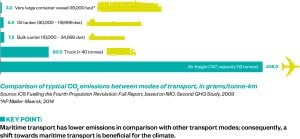Environmental Performance: Comparison of CO2 Emissions by Different Modes of Transport
Overview
Shipping is the least environmentally damaging form of commercial transport and, compared with land based industry, is a comparatively minor contributor to marine pollution from human activities.
There has been a substantial reduction in marine pollution over the last 15 years, especially with regard to the amount of oil spilled into the sea, despite a massive increase in world seaborne trade.
Comparison of CO2 Emissions by Different Modes of Transport
The shipping industry is a small contributor to the total volume of atmospheric emissions compared to road vehicles and air transport (see graph below) as well as public utilities such as power stations, and atmospheric pollution from ships has reduced in the last decade. There have been significant improvements in engine efficiency and hull design, and the use of ships with larger cargo carrying capacities have led to a reduction in emissions and an increase in fuel efficiency.
In terms of CO2 emissions per tonne of cargo transported one mile, shipping is recognised as the most efficient form of commercial transport. However, the enormous scale of the industry means that it is nevertheless a significant contributor to the world’s total greenhouse gas emissions (around 3% of total global CO2 emissions).
The industry is therefore closely involved in global discussions on ships’ CO2 emissions now being firmly led by IMO. More information about what the shipping industry and IMO are doing to deliver a significant reduction in shipping’s CO2 emissions can be found here.

Related content

Reducing Greenhouse Gas Emissions: A Guide to IMO Regulatory Compliance

Shaping the Future of Shipping Summit

ICS report reveals scale of challenge to decarbonise shipping
